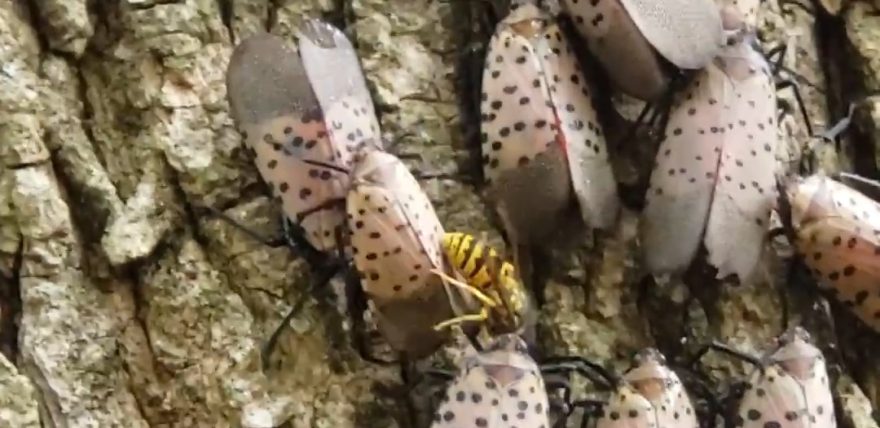
Spotted Lanternflies Help Stinging Insects Thrive
September 2, 2020No doubt about it. Stinging insects are some of the most common pests we’re asked to control. Increasingly, service calls to kill the Spotted Lanternfly are high on the chart too.
This year, we’ve gotten more calls than ever regarding both! There’s an abundance of bald face hornets, yellowjackets, wasps, and European hornets joining the swarms of spotted lanternflies. (European hornets look like Murder hornets, but they are not. The Asian Giant hornet is dubbed the “murder hornet.” Learn more.)
Service calls to control yellowjackets, wasps, and other stinging insects have increased dramatically this year and started earlier. Greg Pettis, Dominion’s president, recently went out into the field to help catch up on stinging insects calls. Scary!
Spotted Lanternflies ‘Aid’ Wasps and Hornets
We believe that lanternflies may be one of the reasons we’re getting more requests to control stinging insects at residential and commercial properties throughout Lancaster County.
While out on service calls, our pest control technicians have witnessed something spectacular recently with adult lanternflies and yellowjackets. When treating trees to control Spotted lanternflies, technicians noticed stinging insects like yellowjackets bullying the SLF out of their way to take over the sap flow.
Yellowjackets also like the honeydew (the sugary substance excreted from the spotted lanternflies).
That SPF honeydew is what creates sooty mold to grow on trees, causing serious tree dieback. It’s also a sappy substance that yellowjackets and other stinging insects crave.
SLF is kind of “doing the work” and exposing tree sap abundantly, so the stinging insects are thriving more than ever.
Control Stinging Insects Near Your Home
Yellowjackets, members of the wasp family, are not true pollinators and they can be dangerous. If you see wasps, or yellowjackets on your home or Western yellowjackets and bumblebees in the ground, or hornets in a tree or on the side of a structure like a home, garage, or shed, you might have an infestation that requires professional pest control.
These wasps, and other types of wasps, can break through into your house. They will build nests in wall voids. These wasp nests can go unnoticed until the nests expand. Small holes will appear in your drywall as the yellowjackets make their way inside. Sometimes customers will report hearing a buzzing sound inside the wall prior to breakthrough.
Dominion technicians can treat yellowjacket nests, so they don’t break through and threaten your family. We can treat your home preventively, or if there is an active nest, we can eliminate the threat by treating it.
Using over-the-counter products is “counter-productive.” Doing so can provoke the situation and push the stinging insects into the living areas of your home. This complicates the situation, and Dominion techs must get creative to shut down the threat.
European Hornets Eat Spotted Lanternflies
Our pest control technicians report another interesting observation: Yellowjackets and European hornets are eating dead spotted lanternflies!
Through easier access to sap and cadaver nutrition, stinging insects consider the spotted lanternfly an easy food source.
It’s not yet known whether this behavior of stinging insects will impact the number of Spotted lanternflies. SLF infestation is immense. Expect to see the Spotted Lanternfly everywhere — on trees, bushes, patios, decks, etc.
The PA Department of Agriculture has tried to contain the Spotted Lanternfly through quarantining, but that hasn’t been as successful as we had hoped.
How to Kill the Spotted Lanternfly
Among possible long-term solution is a fungus found naturally occurring in Berks County. Researchers with the PA Dept. of Agriculture are quarantining areas for testing the fungus. They are also looking into a parasitic wasp under quarantined testing.
For now, to control Spotted Lanternfly, we recommend:
- Application to trees: We can systemically treat bark and roots so that SLF gets the product when they go to suck the tree sap.
- Application of a topical product with a pesticide. When the SLF lands on the tree, it kills them and prevents them from sap-sucking.
- Use of sticky trap tape around the tree in conjunction with chicken wire or hardware cloth to trap them.
Dominion most commonly treats rose bushes and burning bushes, in addition to these trees: mostly maples, sumac, cherry willow trees, black walnut, and many others. The species of trees impacted by spotted lanternflies are too numerous to list.
Do All Trees Need to be Treated for SLF?
No. Dominion Pest Control is treating trees that are being attacked. The Tree of Heaven is the spotted lanternfly’s preferred tree. The Pennsylvania Dept. of Agriculture recommends you cut down as many as you can and save at least one to serve as a bait tree. Then, kill the pests by treating that tree.
We encourage you to inspect your trees. If you see the eggs being laid on the trees in late fall, that means the nymphs will target that tree in the spring and you should have that tree treated.
Due to high call volume concerning spotted lanternfly infestations, we have many customer care representatives trained to answer questions regarding SPL and ready to set up your property’s spotted lanternfly treatments.